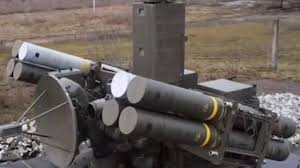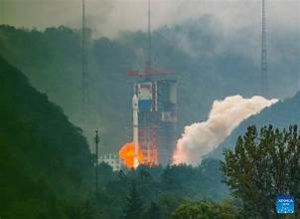Ukraine’s air defense crippled by France’s 18-month drought

Paris: In a revelation that underscores the challenges facing Ukraine’s air defense capabilities, French media outlet Le Monde reported on May 26, 2025, that Ukraine has not received a single missile for its Crotale air defense systems in the past 18 months.
This drought in critical munitions, vital for countering Russia’s relentless aerial assaults, has left Kyiv grappling with a weakened defense network at a time when Russian drone and missile strikes continue to pummel Ukrainian cities and infrastructure.
The absence of these missiles, specifically the VT-1 used by the Crotale NG systems, raises questions about France’s commitment to supporting Ukraine’s defense and highlights broader issues in Western military aid logistics.
The situation, unfolding amid Ukraine’s desperate need to shield its skies, stems from a complex interplay of production constraints, strategic priorities, and logistical hurdles, leaving Ukraine increasingly vulnerable to Russian air attacks.
France’s delivery of Crotale systems to Ukraine dates back to late 2022, a period when Western allies scrambled to bolster Kyiv’s defenses against Russia’s intensified air campaign.
According to French Defense Minister Sébastien Lecornu, speaking to Le Journal du Dimanche on November 20, 2022, France supplied two Crotale NG batteries to Ukraine, drawn directly from the French Air Force’s inventory of 12 systems stationed at bases such as Istres, Avord, and Mont de Marsan.
These batteries, each typically comprising one acquisition unit and two to four launchers, were intended to counter low-flying threats like drones and cruise missiles, which have been a hallmark of Russia’s strategy.
The decision to transfer these systems was part of a broader French commitment to provide €550 million in military aid, including 18 Caesar howitzers and Mistral missiles, as Lecornu detailed.
However, the exact number of VT-1 missiles initially provided remains undisclosed, with the French Ministry of Defense labeling such data as confidential. The transfer, while significant, reduced France’s own Crotale NG stockpile, a move some French analysts criticized as a potential strain on national defense capabilities, given the system’s planned replacement by the more advanced VL-MICA system.
The absence of VT-1 missile deliveries for 18 months, as reported by Le Monde, prompts a deeper examination of why France has failed to replenish Ukraine’s stocks. Several factors likely contribute, each carrying its own weight and complexity.
One plausible explanation is the limited production capacity of MBDA, the European consortium responsible for manufacturing VT-1 missiles. The VT-1, developed in collaboration with LTV Missiles and Electronics Group, relies on a production line that has not scaled to meet the demands of a high-intensity conflict like Ukraine’s.
Unlike widely produced munitions like 155mm artillery shells, the VT-1 is a specialized missile used by a small number of operators, including France, Finland, Greece, and South Korea. MBDA’s focus in recent years has shifted toward newer systems like the VL-MICA, which may have relegated VT-1 production to a lower priority.
A 2023 report from meta-defense.fr highlighted Europe’s broader struggle to ramp up missile production, noting that the continent’s defense industry lacks the capacity to match the rapid depletion rates seen in Ukraine’s air defense operations.
Another factor could be France’s strategic prioritization of its own military needs and those of other allies. France’s limited stockpile of VT-1 missiles, also used in naval variants of the Crotale system on ships like the La Fayette-class frigates, may have constrained its ability to spare additional munitions for Ukraine.
The French Navy, for instance, maintains 18 missiles per Crotale-equipped vessel, and with ongoing commitments in the Mediterranean and Indo-Pacific, Paris may be reluctant to deplete its reserves.
Similarly, other Crotale operators like Finland, which relies on the system [designated ITO 90] for its air defense, may have requested priority access to MBDA’s limited output, especially given heightened tensions with Russia along NATO’s eastern flank.
A French military source, emphasized that France’s arms deliveries to Ukraine often come from existing stocks, which are finite and require careful management to avoid compromising national security.
Logistical challenges further complicate the picture. Delivering missiles to Ukraine involves navigating a complex supply chain, from production facilities in France to forward bases in Poland or Romania, where NATO coordinates aid transfers. The process is fraught with delays, as evidenced by Ukraine’s broader struggles to secure timely deliveries of Western munitions.
Ukrainian Defense Minister Rustem Umerov, in a meeting with French counterparts in early 2025, reportedly raised concerns about the slow pace of aid, according to Corriere della Sera. The lack of VT-1 deliveries may also reflect bureaucratic hurdles or political hesitancy within France, where figures like Marine Le Pen have publicly questioned the wisdom of extensive arms transfers.
In a November 2022 interview with France Inter, Le Pen argued that such deliveries could prolong the war, a sentiment that may influence domestic debates over prioritizing Ukraine’s needs.
The financial aspect cannot be overlooked. France established a €100 million fund in 2022 for Ukraine to purchase equipment directly from French manufacturers, as noted by Lecornu in Mezha.Media on October 17, 2022.
However, there is no evidence that Ukraine used this fund to procure additional VT-1 missiles, possibly due to competing priorities like artillery or longer-range systems. The high cost of specialized missiles like the VT-1, estimated at €200,000–€300,000 per unit based on defense industry analyses, may also deter rapid replenishment, especially if France expects Ukraine to finance such purchases independently.
From a critical perspective, the 18-month gap in deliveries raises questions about France’s long-term commitment to Ukraine’s defense. While Paris has been vocal about its support, the lack of follow-through on Crotale munitions suggests a disconnect between rhetoric and action.
Some analysts argue that France, wary of escalating tensions with Russia, may cautiously calibrate its aid to avoid provoking Moscow. Others contend that the issue is purely practical, rooted in the realities of a strained defense industrial base. The truth likely lies in a combination of these factors, with production bottlenecks, strategic priorities, and logistical constraints converging to create a supply shortfall.
The impact of this shortfall on Ukraine’s air defenses is profound. The Crotale NG, designed to intercept low-flying threats, plays a critical role in protecting Ukrainian cities and infrastructure from Russian drones like the Shahed-136 and cruise missiles such as the Kalibr.
Without VT-1 missiles, these systems are effectively sidelined, reducing Ukraine’s ability to counter the low-altitude, high-volume attacks that have characterized Russia’s air campaign.
Ukrainian Air Force spokesperson Yuriy Ihnat, quoted in Le Monde on May 26, 2025, underscored the strain on Ukraine’s air defense network, noting that the lack of munitions for systems like Crotale exacerbates vulnerabilities in regions like Odesa and Mykolaiv, where Russian strikes have intensified.
The absence of Crotale’s capabilities forces Ukraine to rely more heavily on other systems, such as the U.S.-provided Patriot or the Norwegian NASAMS, which are better suited for higher-altitude or ballistic threats but less effective against low-flying drones.
This dependency creates a cascading effect. Patriot systems, for instance, use expensive PAC-3 missiles, costing up to $4 million each, to engage targets that Crotale could handle more cost-effectively. A Ukrainian commander, identified only as Artem in The Wall Street Journal, reported that the southern front lacks adequate protection against ballistic missiles, a problem compounded by the non-functionality of Crotale systems.
The depletion of VT-1 stocks also heightens the vulnerability of critical infrastructure, such as power plants and railway hubs, which have been prime targets for Russian strikes. In a single 24-hour period in May 2025, Russia launched 367 air attacks, including 298 Shahed drones, according to Ukrainian military reports. Without Crotale’s rapid-response capabilities, Ukraine struggles to maintain a layered defense, leaving gaps that Russian forces exploit.
The pressure on Western allies to address this shortfall is mounting. Ukrainian President Volodymyr Zelensky, speaking at a NATO summit in early 2025, emphasized the need for sustained missile supplies, warning that delays embolden Russia’s aggression.
Umerov’s discussions with French and Italian officials, as reported by Corriere della Sera, reflect Kyiv’s urgency to secure VT-1 missiles and other munitions. Yet, the response from France has been muted, with no public commitments to resume deliveries as of May 2025. This inaction fuels frustration among Ukrainian officials and raises questions about the cohesion of NATO’s support strategy.
The Crotale system’s primary role is to neutralize low-altitude threats, a mission-critical in Ukraine’s context. The VT-1 missile, with its Mach 3.5 speed and 11–15 km range, is designed to engage drones, cruise missiles, helicopters, and low-flying aircraft.
Its pulse-Doppler radar and infrared guidance allow it to track and intercept targets with high precision, even in dense electronic warfare environments. In Ukraine, Crotale has proven effective against Russian Shahed-136 drones, which fly at altitudes below 6 km and speeds under 200 km/h, as demonstrated in a March 2023 video released by the Ukrainian Air Force showing a Crotale NG intercepting a Russian cruise missile.
Without VT-1 missiles, Ukraine cannot counter these threats effectively, leaving civilian and military targets exposed. For instance, Russian Kalibr cruise missiles, which often fly at 50–100 meters to evade radar, are ideal targets for Crotale but require sustained missile supplies to maintain defensive coverage.
Compared to other systems in Ukraine’s arsenal, Crotale occupies a unique niche. The U.S.-provided Patriot PAC-3, with a range of 100 km and a ceiling of 24 km, excels against ballistic missiles but is overkill for low-altitude drones.
The NASAMS, supplied by Norway, offers a 40 km range and is effective against cruise missiles but lacks the rapid-response capability of Crotale for close-in defense. The German IRIS-T SLM, with a 40 km range and 20 km ceiling, provides a balanced capability but is not optimized for the ultra-low-altitude threats Crotale targets.
The Soviet-era S-300 systems, still in use by Ukraine, have a longer range but struggle against modern drones due to outdated radar systems. The Crotale’s compact design and quick setup time—five minutes from transport to combat readiness—make it ideal for protecting mobile units and urban areas, a flexibility unmatched by heavier systems.
Critically, the absence of VT-1 missiles undermines Ukraine’s multi-layered defense strategy, which relies on a combination of short-, medium-, and long-range systems to counter Russia’s diverse aerial threats. The lack of Crotale munitions forces Ukraine to expend scarce resources on less suitable systems, draining stocks of Patriot or NASAMS missiles that are harder to replenish.
This dynamic highlights a broader issue: Western allies, including France, have struggled to match their rhetorical support with consistent materiel deliveries. While the U.S. has provided $75 billion in aid since 2022, France’s contributions, though significant, pale in comparison, totaling €2.1 billion by early 2024, according to the French Ministry of Defense.
The failure to supply VT-1 missiles suggests a gap in strategic foresight, as Ukraine’s ability to resist Russian aggression hinges on sustained access to munitions.
The Crotale NG system, developed by Thales and armed by MBDA, is a sophisticated short-range air defense platform that has evolved since its inception in the 1960s. Originally designed for South Africa under the name Cactus, it was adopted by the French Air Force in 1972 and upgraded to the NG variant in 1990.
The system comprises a fire-control vehicle with an S-band Mirador IV Doppler radar, effective up to 20 km, and two to four launchers, each carrying eight VT-1 missiles. The VT-1, developed with LTV and powered by a Morton Thiokol solid rocket motor, achieves speeds of Mach 3.5 and can maneuver at 35G, making it highly effective against agile targets.
Its 13 kg warhead, with an 8-meter kill radius, is optimized for drones and cruise missiles. The system’s Ku-band tracking radar and electro-optical sensors, including thermal and daylight cameras, enable precise targeting up to 15 km, even in adverse conditions. The Crotale NG can track eight targets simultaneously and engage two within seconds, a capability demonstrated in Ukraine in March 2023.
The system’s versatility extends to its naval variant, used on French frigates like the La Fayette class, where it protects against anti-ship missiles. The towed version, as supplied to Ukraine, is mounted on a trailer for rapid deployment, requiring only two operators—a driver and a gunner.
The Crotale NG’s compact design, with a 4.3-ton turret, allows it to be integrated onto various platforms, including trucks and armored vehicles. Compared to competitors like the U.S. Chaparral, which uses Sidewinder missiles with a shorter range, or the Russian Pantsir-S1, which has a similar 15 km range but is less mobile, the Crotale NG offers a balance of speed, precision, and portability. Its limitations, however, include its inability to engage ballistic missiles, a role better suited to systems like the SAMP/T or Patriot.
The 18-month hiatus in VT-1 deliveries underscores a critical vulnerability in Ukraine’s defense and raises broader questions about the West’s ability to sustain prolonged support for Kyiv. While France’s initial delivery of Crotale systems was a meaningful gesture, the failure to follow through with munitions risks undermining Ukraine’s ability to protect its people and infrastructure.
As Russian attacks intensify, with over 300 air strikes reported in a single day in May 2025, the absence of Crotale’s capabilities leaves a gap that other systems cannot fully fill. The situation demands urgent action from France and its allies to address production bottlenecks, streamline logistics, and prioritize Ukraine’s needs.
Without renewed deliveries, Ukraine’s air defenses will continue to falter, potentially altering the course of the conflict. Can France, a key NATO player, afford to let this shortfall persist, or will it rise to meet the challenge before Ukraine’s skies become indefensible?





